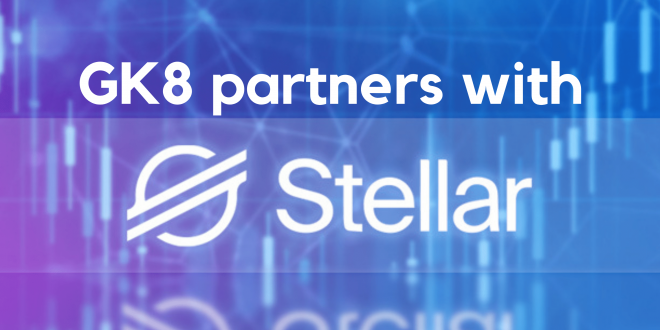GK8 partners with Stellar: Demand for institutional-grade blockchain solutions is rising as banks and traditional financial institutions look to invest in cryptocurrencies. The stellar Network will be able to utilize custody and tokenization services by blockchain cybersecurity company GK8, Stellar Lumen (XLM) token might attract institutional interest with this move. XLM investments can now be managed under Stellar’s custody model, enabling customers of GK8 to carry out offline transactions of the digital currency, the company said Monday.
Cyberattacks are eliminated by GK8’s infrastructure, while high-frequency, scalable transactions can also be performed. According to CEO Lior Lamesh of XLM, the partnership can generate new revenue streams for investors, enable them to store their assets digitally, and allow real-time trading and currency transformation. A blockchain-based payment network forked from XRP in 2014; Stellar operates as a payment system for cryptocurrencies.
There are currently 22 active crypto projects with a total market capitalization of $9.8 billion, making XLM the 22nd most valuable. Based on CoinMarketCap, there has been a gain of 23% in the token a week. Throughout the past year, GK8 has forged high-profile partnerships alongside the continued expansion of institutional blockchain infrastructure. A State Street-backed tokenized infrastructure company, Securrency, partnered with GK8 in August, Cointelegraph reported. It has also partnered with Mastercard for its Startup Path initiative. A new use case for digital assets is leading to a rise in institutional appetite for cryptocurrencies.
An increasing number of wealth managers have started investing in crypto for the first time or have expanded their holdings. As reputational risks have been mitigated in crypto investing, financial advisers may be leading the adoption drive. Traditional financial institutions are also offering institutional custody services. The 103-year-old Cowen Bank informed asset managers and hedge funds that it wanted to possess cryptocurrencies on behalf of them. Up to this point, Stellar Lumens has been forgotten despite its lovely promise. However, Stellar failed to become a formidable competitor to Ripple like its co-founder, Jed McCaleb.
Stellar cryptocurrency: What it is and how to use it
Digital or virtual currencies developed through the use of decentralized networks known as blockchains are called Cryptocurrencies. The purpose of this was to prevent counterfeiting of the currency. In addition, the coins would not be double-spent. The government does not intervene in trading cryptocurrencies because central banks don’t issue them like fiat money. The success of Bitcoin in 2009 gave rise to a variety of cryptocurrencies, such as the lumen.
In addition to the lumen, Stellar has a cryptocurrency called the XLM. With a maximum supply of 50 billion coins, about 22.5 billion coins are in circulation today. Over 100 billion lumens have initially been available to the Stellar Foundation; approximately half of its coins were burned in November 2019. XLM’s price rose briefly following the move but quickly sank back down.
There is controversy about coin burns because they suggest centralized systems are vulnerable to manipulation. Stellar lumen is ranked 11th on CoinMarketCap despite a more than two-thirds decline in value between May 2020 and May 2018. As of March 25, 2021, Zewsi was valued at approximately $8.3 billion.
GK8 partners with Stellar: The Future is Stellar
Stellar offers remittance services and bank loans to those not eligible for banking services, primarily developing economies. Customers do not pay for the use of Stellar’s Network. In Stellar, the exchange mode is distributed. In this way, users can enter payment amounts in specific currencies, despite having credit balances in other currencies, while the Network conducts the currency conversion automatically. They can withdraw the equivalent in their currency by going to a partner institution like a bank.
Stellar charges significantly lower transaction costs and reduces time lags because it connects financial entities, allowing cross-border transfer and payment. Although Stellar works very much like technologies such as Bitcoin, its consensus protocol makes it unique. Thanks to the Stellar Consensus Protocol (SCP) created as part of an October 2014 fork, Stellar is now an open-source system. With this protocol, only a few trusted nodes can authenticate transactions instead of the entire Network.
The Network’s nodes select a set of trusted peers, and approval is based on the authentication of those who belong to this select group. Stellar’s shorter approval cycle also helps to lower transaction costs and speed up the transaction process.
What is the problem with Stellar Lumens?
Currently, scalability is a critical factor for the coin’s performance and the community’s success. It becomes redundant to say that the best technology equals the best interest. Many seemingly successful blockchain initiatives have disappeared from the market. An excellent example of one of those initiatives is Stellar Lumens. The price of XLM is roughly 22% lower at $ 0.31 at publication time after Bitcoin fell to $ 43,000 at the end of the evening, and the market struggled to reach double digits.
It is aimed at non-banking people and can handle over 250 transactions per second (TPS). Likewise, it has expanded to support app storage, such as SatoshiPay, and corporations such as Wirex. The Stellar Lumens’ dream of creating their very own Visa playing cards that can be used to spend 12 currencies anywhere seems to be gaining popularity at the moment. In the banking sector, XRP has emerged as a major player since its partnership with a third of the world’s banks. Additionally, it can send more than 1500 TPS, making it an even better option than Stellar.
What is the future of Stellar?
With ETH 2.0 and the Lightning Network (LN) poised to hit the market within 12 months, Stellar is now against ETH 2.0 and LN. A dominance of 25 million TPS and the higher hand in the LN and dApp sectors can be attributed to Ethereum. This is also the point where Stellar Lumens have the potential to excel – Ripple is primarily a monetary tool while LN and ETH 2.0 continue to reach their potential. Therefore Stellar Lumens is a good choice. In addition, over 6.5 million transactions are still performed within the XLM community every day.
Peruvian stablecoin launches on the Stellar blockchain.
Peru’s Anclap is adding a stablecoin to its Stellar Network by launching a Stellar-based stablecoin. Cointelegraph en Español informs. With this stablecoin, you will be able to conduct instant transactions on the Anclap Network pegged to the official fiat currency of Peru, the Peruvian sol (PEN). The company announced on 25.09 that it would convert its assets to other fiat currencies and other digital assets, including “everything else.”Stellar, or the Stellar Network, allows stability coins to be integrated into any platform, and the stable coin they provide is called the “digital sol.”
There is now an option for digital sol to be bought on websites with various digital wallets and an exchange rate for foreign currencies, including the Argentine peso and Brazilian real. In an interview with A Clap, co-founder Ivan Mudryj explained that Digital Sol lets Peruvians and businesses exchange currency values with anyone in the world within minutes and for minimal cost. Since January 2020, Digital Sol has been working on its Argentine peso-linked stablecoin following Stellar’s launch in January.
Stellar Network is currently connected to the stablecoins of Argentina and Peru, according to an article On Clap wrote on September 24. Stablecoins will be introduced in October and November, respectively, for the Colombian peso and Chilean peso. The website of Anclap indicates that other stablecoins are still in issuance. Such as the digital Mexican peso and Brazilian real. Anclap is developing a digital payment network to replace slow and costly banking transactions using Stellar.
Anclap said that stablecoins have not only paved the way for a new country, but millions of citizens are now able to build a better future for themselves. Consider this when tweeting using digital sol. Sol is being launched by Digital Currency Corp. when the private stablecoin market is overgrowing, reaching almost $ 130 billion worth at the end of September 2021 from $ 37 billion in January. Stablecoins have exploded in popularity, catching the attention of regulators around the world. Many jurisdictions plan to regulate them more strictly.
This presentation compares the transaction speeds of the major cryptocurrencies, such as Cardano, XRP, Solana, Celo, Alogrand, and Stellar Lumens.
WEF, a Swiss-based nonprofit organization, explains the rate at which some crypto-assets can be used for transactions, including Cardano, XRP, Solana, Celo, Alogrand, and Stellar Lumens. Recently, the WEF published a report that examined Cardano’s (ADA) intelligent contract platform and provided statistics on how many transactions it will likely execute every second. Developed in the name of the Proof of Stake (PoS) blockchain, Cardano is an open-source platform for smart contracts and blockchain communities. It allows 257 transactions per second.
I then proceed to the XRP Ledger (XEPL) and its international open-supply blockchain. A transaction on XRP’s blockchain is processed in three seconds, and it can handle more than 1,500 transactions per second.”Furthermore, the WEF highlights the pace and infrastructure of Solana (SOL), which is described as the first community focused on enabling mainstream adoption of blockchain technology.
Due to the system’s flexibility, Solana can support fast transaction times without requiring Layer 2 systems or sharding to scale. The WEF discussed Celo as another cryptocurrency asset. WEF recommends Celo should allow smartphone customers to receive, send, and store cash. During 1,000 transactions per second, Celo’s ledger closes in around 5 seconds.
In addition to ALGO, the checklist should also include Agorand (ALGO). A centralized and decentralized system of applications (DApps) developed by Algorand is acknowledged as an integrated community by the World Economic Forum. Agorand has a closing time of around five seconds away from the ledger, allowing 1,000 transactions per second.
Stellar Lumens (XLM) is the last venture, with the WEF claiming to be a cross-border fund. There are 1,000 Stellar Ledgers in existence at present. 250 transactions are processed per second when the ledger is closed in 5 seconds.
FAQs:
Consensus is reached using the stellar consensus protocol, a variant of the Federated Byzantine Agreement (FBA). Thanks to SCP’s fast, cheap processing, a transaction can be verified as valid or invalid in just a few seconds.
A price rise of nearly 30,000 percent is needed for XLM to reach $100. Though this is still possible, it isn’t typical for established cryptocurrencies. A gradual price increase is the result of incremental improvements and partnership efforts.
Presently, XRP offers a greater return than XLM. As a network, Stellar would be a better investment than Ripple (as a network). Because of that, I hold both tokens as they can sometimes be more valuable than the Network itself. Risk is inherent to any investment.
Sure. Taking into account the BTC/XLM ratio, bitcoin would be valued at $12.5 million. Will Stellar Lumens be a profitable investment in 2020? An economic forecasting model utilized by the Economy Forecast Agency predicts a Stellar lumen price of $0.64.
A contract between Stellar Development Foundation and the Ministry of Digital Transformation of Ukraine was signed in early January 2021 as part of the Stellar developer partnership. In the same way that Stellar’s protocol uses blockchain technology, DLT uses the same technology.
 Next Tech Magazine Get The Latest Technology Updates
Next Tech Magazine Get The Latest Technology Updates







